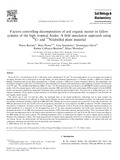| dc.description.abstract | N-rich (C:N ¼ 27) and N-poor (C:N ¼ 130) wheat straw, labelled with 14C and 15N, was incubated for 2 yr in two major ecosystems of the upper elevation belt of cultivation in the high Andes: the moist Paramo (precipitation ¼ 1329 mm, altitude ¼ 3400m asl, Andes of Merida, Venezuela) and the dry Puna (precipitation ¼ 370 mm, altitude ¼ 3800m asl, Central Altiplano, Bolivia). The experiment was installed in young (2 yr) and old (7 yr) fallow plots. The following soil analyses were performed at nine sampling occasions: soil moisture, total-14C and -15N, and Microbial Biomass (MB)-14C and -15N. The measured data were fitted by the MOMOS-6 model (a process based model, with five compartments: labile and stable plant material, MB, and labile (HL) and stable humus (HS)) coupled with the SAHEL model (soil moisture prediction) using daily measured and/or predicted meteorological data. The aim was to understand how (1) the climatic conditions, (2) the quality of plant material, (3) the fallow age and (4) the soil properties affect the cycling of C and N within the
soil organic matter system. The fallow age (2 and 7 yr) did not affect the measured data or the model predictions, indicating that in these systems the
decomposition potential is not affected by fallow length. During the short initial active decomposition phase, the labile plant material was quickly exhausted, enabling a build up of MB and of HL. During the low activity phase, that covered 4/5 of the time of exposure, the MB size decreased slowly and the HL pool was progressively exhausted as it was reused by the MB as substrate. The HL compartment was directly or indirectly the major source for the inorganic 15N production. If the C:N ratio of the added plant material increased, the model predicted (1) a reduction of the decomposition rates of the
plant material (essentially the stable plant material) and (2) an increased mortality of the MB which increased the production of HL (microbial cadavers
and metabolites). Thus the essential effect of the slower decomposition due to the N-poor plant material was a higher accumulation of C and N in the HL and
its slower recycling by the MB during the low activity phase. The labelling experiment allows to understand the higher soil native organic matter content in Paramo soils compared to Puna. The large sequestration of organic matter generally observed in the Paramo soils can be explained by two abiotic factors: the unfavourable soil microstructure and the accumulation of free aluminium linked to the climatic and acid soil conditions, inhibiting the microbial activity physically and chemically. | es_VE |


